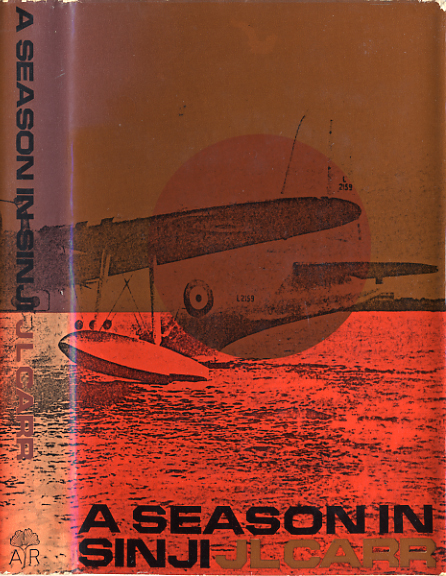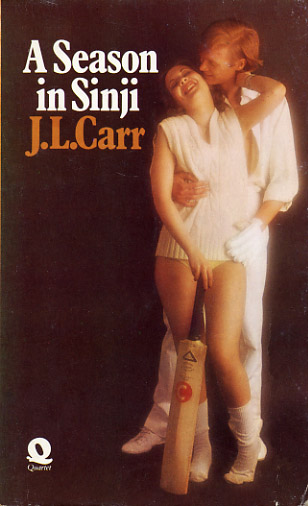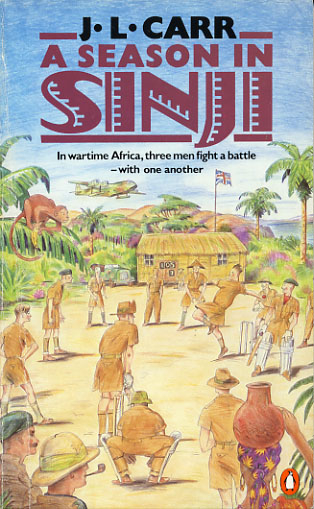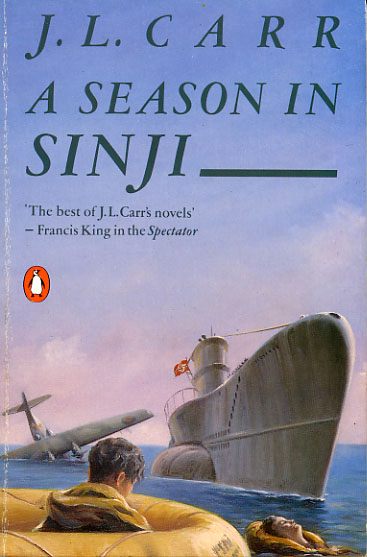A Season in Sinji
This was Carr's second novel, for which he was paid an advance of £125. It is based on Carr's experiences in the Royal Air Force during the Second World War. In a paperback copy of this novel Carr identified R.A.F. Blackfen as R.A.F. Padgate; R.A.F. Budmouth as R.A.F. Chivenor; and R.A.F. Sinji as R.A.F. Jui in Sierra Leone, now Gambia.
● First edition, only impression
Publisher: Alan Ross Ltd, London
Date of publication: 1967
ISBN: none
Size: 202 x 137mm
Pagination: 192 pp
Binding: plain brown cloth; title in capitals in gold along length of spine with logo of the publisher at the foot
Dust jacket design: no credit, possily photo by J.L.Carr (see below)
Printed by: Hazell Watson & Viney Ltd, Aylesbury, Bucks
Price: 25 shillings
Copies sold: 2,009 (Rogers, 2003, p 211)
Royalty: £214, with paperback rights £482 (Rogers, 2003, p 211)
Inside front flap: In this revealing and haunting novel of service life, Flanders, a Yorkshireman, tells what happens in a single dry season on the coasts of wartime West Africa. But the story's roots are deep in an earlier English spring when Flanders and his friend Wakerly, both aircraftsmen, become inarticulately infatuated with the same girl. She marries neither but falls for Turton, their smooth and licentious colleague.

Front panel and faded spine of dust jacket
It is their misfortune that Turton, now commissioned, is posted to Sinji, their flying-boat station, as adjutant. What at first seems an uneven contest now begins again and, when it ends, all three have lost. As Flanders, waiting to die alone in the South Atlatic says, He had lost: that much was certain. But had I won? I lost something at Sinji, and its last shred went that afternoon. The last hours with Turton destroyed what I thought I was. We all lost. One after the other.....me, last of all - because until then, I still believed that every game must have a winner.
Engagingly written, with a deceptively light touch, this novel re-creates life on an R.A.F. station in an African backwater with impressive fidelity. The dialogue, memorably evoking a wide range of characters, crackles with black and savage humour, and in the bizarre cricket match which acts as a kind of catharsis to the novel's mounting passions, the human dramas are effectively resolved.
Inside rear flap: J.L. Carr was brought up in villages on the Vale of Mowbray and the Plain of York where his father's family has lived for many generations. He was educated at Carlton Miniott and Sherbern-in-Elmet, as well as Castleford Secondary School where, like Henry Moore, he studied under its remarkable headmaster, T.R. Dawes.
During the war, Carr was a tradesman-corporal and, later, an intelligence officer in the R.A.F.
At present, he makes a living by publishing local guides and by writing. He lives at Kettering.
Notes: Carr reported in an article in The Author published in 1983 that it sold 2,000 copies and he bought 100 remainders for 1 shilling each. However in a letter dated 11th January 1974 to Alan Ross' business partner in London Magazine Editions, the Marquis of Hartington, he wrote:
Thank you for your letter about remaindering A Season in Sinji but, in 1970, Calder and Boyer informed me that it was to be remaindered and I bought a very large number of copies from them at, I believe, two shillings and three pence each and which I resold.
Alan Ross of London Magazine Editions published Carr's fourth novel How Steeple Sinderby Wanderers Won the F.A. Cup.
The photograph on the dust jacket is of a Short Sunderland Mark 1 flying boat of the type in which Carr flew when he was with 270 Squadron stationed at RAF Bathurst in Sierra Leone (now Gambia), between November 1942 and July 1943. As Carr was trained by the RAF to be an aerial photographer, I suspect that he took the photograph. The specific 'plane, L2159, was the second of the type produced, in 1938, according to the Wikipedia article. This 'plane patrolled the waters off the coast of West Africa looking for German submarines.
When Carr was getting Steeple Sinderby ready for publication he wrote to Alan Ross: I thought the cover of Sinji was first-rate and booksellers have told me this on my rounds... A cover they remembered.
Inscriptions seen in copies of the book
The original title was A Game of Cricket because it was meant to be a serious novel of a contest of wills between two men using cricket as the theme (as one cd have used money, ambition or anything else). Thus it is a very different story to Hugh de Selincourt's Cricket Match.
Well now, this is the novel you have been awaiting for more than thirty years! Knowing those far off days in that far off land and recalling 270 Sqdn seeking a fixture with that team with its astonishing title, "The Repatriated Sargeant", I feel you'll really get the flavour of this story. You know I can't recall when you were posted from Fiji (I next recall meeting you at Half Die, The Gambia after both of us very properly (!) had been commissioned) so perhaps you'd already gone when the game - almost faithfully mentioned on pages 146/157, took place. Yes it really happened - the side which as an AC2, I'd carefully nurtured was taken over by a LA-DI-DA F/O and the aftermath took place. But the sequel isn't here - our real adjutant (who later worked on Sainsbury's staff) & W/O Thurles took the man apart & the game was played again & this time WE batted first. Well, I won't go on!! This was the 2nd of 4 novels. No, there's no money in it. I do it for love! I changed my job from a Headmaster to a Publisher about 12 years ago. Jim.
● Second edition
Publisher: Quartet Books, London
Date of publication: 1976
ISBN: 0-704-31098-8
Size: 180 x 113mm
Pagination: 6 pp prelims, 150 pp,4 pp ads
Binding: printed card wrappers
Cover photography by: Keith Silva
Price: U.K. 75 p, Canada $2.95, Australia $2.30, New Zealand $2.25
Printed by: Hunt Barnard Printing Ltd, Aylesbury, Bucks
Inscription:
Ignore the awful cover & the outragoeus inscription on the back cover (the publishers not mine!) But this is probably the truest picture of the wartime RAF ground staff & particularly of an overseas posting.

Front cover
● Third edition, first impression
Publisher: Penguin Books
Date of publication: 1985
ISBN: 0-14-006919-4
Size: 180 x 113 mm
Pagination: 192 pp
Binding: printed card wrappers
Cover illustration: Ken Cox
Printed by: Richard Clay (The Chaucer Press) Ltd, Bungay, Suffolk
Price: U.K. £1.95, Australia $4.95, New Zealand $8.95, Canada $4.95
Inscriptions:
Disregard this ridiculous cover picture utterly. The story is not like that.
This novel’s material came from war service in the Royal Air Force 1940-1946, first as a corporal-photographer, later as a squadron intelligence officer. The settings are Chivenor in Devon, Padgate in Lancaster and Jui in Sierra Leone. Some of the things which happened are true – things like the torpedoing of the troopship and the cricket matches. The final cricket match is utterly true – as is the incident of the shoe less girl and her later minder. It was written in the evenings after tiring days working at school and whilst keeping Bob company in the back bedroom when he was working to gain entrance to university.

Front cover
● Third edition, second impression
Publisher: Penguin Books
Date of publication: 1985
ISBN: 0-14-0061919-4
Printing numbers: 3 5 7 9 10 8 6 4 2
Size: 197 x 131 mm
Pagination: 192 pp
Binding: printed card wrappers
Over illustration by: Charles J. Thompson
Printed by: Cox & Wyman Ltd, Reading
Price: £4.95 (sticker) over printed price of £5.90
Notes: This impression was probably issued much later than 1985 as the price is £3 more than the previous impression. The price sticker seems to cover a printed price of £5.90. It is a bigger book, as well, but has the same layout, so just wider margins.

Front cover
More information about later impressions and foreign language editions can be found on the Wikipedia page for this novel.